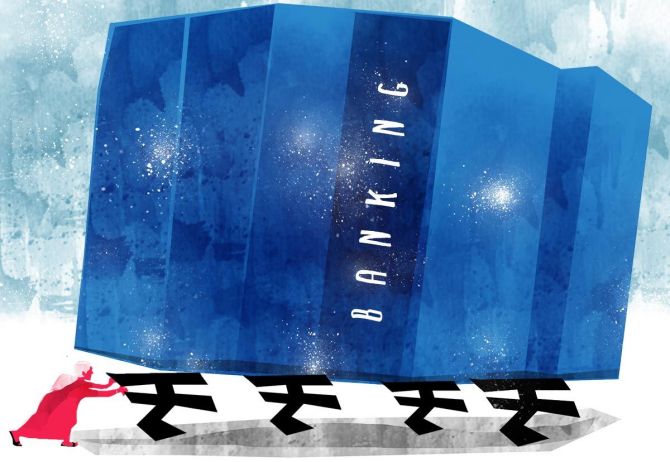As the fight for deposits intensifies, the cost of money will rise and the margin will be under further pressure, points out Tamal Bandyopadhyay.

When a patient is critical, doctors keep checking the level of oxygen in the blood.
The SpO2 reading on a pulse oximeter shows the percentage of oxygen in someone's blood. For a reasonably healthy person, a doctor prefers to check blood pressure and blood sugar.
Replace the patient/healthy person with a bank and the doctor with a banking analyst.
When some Indian banks were in a bad shape, the focus was on the quality of assets: How much non-performing assets (NPAs) these banks had on their books. The NPAs were the oximeter.
Of course, unlike oxygen in blood, lower the NPA, healthier the bank.
When the sector is in a healthy state, the prime focus is on other parameters: The net interest margin (NIM), loosely the difference between what a bank spends on deposits and what it earns on loans; and the low-cost current and savings accounts (CASA). Of course, neither NIM nor CASA can be seen in isolation.
A bank that gives small unsecured loans will have higher NIM than a bank that is into corporate loans, but the unsecured loans can lead to higher NPAs.
Similarly, the cost of CASA for one bank could be higher than the cost of fixed deposits for another.
On a year-on-basis (that is, in the December 2023 quarter over the December 2022 quarter), among all listed banks, six have recorded a rise in NIM.
These are Bandhan Bank Ltd, RBL Bank Ltd, IDFC First Bank Ltd, IDBI Bank Ltd, Bank of Maharashtra and Canara Bank.
For two others -- IndusInd Bank Ltd and Punjab National Bank -- NIM has remained unchanged.
When it comes to the quarter-on-quarter figures (December 2023 over September 2023), there is no uniform trend, but more banks have shown a dip in NIM in December.
For four banks, NIM remained unchanged Q-o-Q. These are HDFC Bank Ltd (3.4 per cent), Kotak Mahindra Bank Ltd (5.22 per cent), Indian Overseas Bank (3.12 per cent) and Bandhan Bank (7.2 per cent).
At least five private banks have registered super-healthy -- over 5 per cent -- NIM in the December quarter.
Bandhan Bank and Kotak Mahindra Bank apart, three others in the list are IDFC First Bank (6.42 per cent), RBL Bank (5.52 per cent) and CSB Bank Ltd (5.1 per cent).
Among public sector banks, Bank of Maharashtra has the highest NIM (3.95 per cent), followed by Indian Bank (3.49 per cent), State Bank of India (3.34 per cent), Punjab National Bank (3.3 per cent) and Central Bank of India (3.28 per cent).
Jammu and Kashmir Bank Ltd has the lowest NIM (0.96 per cent), followed by Yes Bank Ltd (2.4 per cent), Punjab & Sind Bank (2.54 per cent) and Bank of India (2.85 per cent). The rest have at least 3 per cent NIM.
When it comes to CASA, 31 of 32 listed banks have shown a drop Y-o-Y. Tamilnad Mercantile Bank Ltd is the lone exception, though the rise is marginal -- from 29.58 per cent to 30 per cent.
Even on a Q-o-Q basis, the number of banks that have recorded a drop in their low-cost deposits is higher than those that have registered a rise.
HDFC Bank has shown the sharpest drop in CASA Y-o-Y in the December quarter (from 44 per cent to 38 per cent), followed by Kotak Mahindra Bank (53.3 per cent to 47.7 per cent), ICICI Bank (44.6 per cent to 39.4 per cent), IDBI Bank (54.44 per cent to 49.88 per cent), CSB Bank (31.44 per cent to 27.58 per cent), Federal Bank Ltd (34.24 per cent to 30.63 per cent) IDFC First Bank (50 per cent to 46.80 per cent), Jammu and Kashmir Bank (53.76 per cent to 50.59 per cent) and Axis Bank (45 per cent to 42 per cent).
Among public sector banks, SBI has recorded the sharpest drop (41.18 per cent from 44.48 per cent).
Only one bank had more than 50 per cent CASA in the December 2023 quarter versus six banks in December 2022: Bank of Maharashtra (50.59 per cent).
Another four banks have more than 45 per cent but less than 50 per cent: IDBI Bank (49.88 per cent), Central Bank of India (48.98 per cent), Kotak Mahindra Bank (47.7 per cent) and IDFC First Bank (46.8 per cent). DCB Bank has the least CASA (26.13 per cent).
Of course, CASA alone does not give us a sense of the cost of funds for a bank.
While the current account doesn't earn any interest, the interest for the savings account varies from 2.7 per cent to as much as 8 per cent, depending on the bank and the amount of money kept.
What about growth in deposits and advances?
For the listed private banks as a group, the Y-o-Y growth in advances has been 31.35 per cent versus 20.07 per cent growth in deposits.
For 11 public sector banks, the growth is lower in both advances and deposits - 20.18 per cent and 13.85 per cent, respectively, but the trend is the same.
The asymmetry in the growth of deposits and advances is stark in some banks.
For instance, HDFC Bank's advance growth has been 62.34 per cent, while the pile of deposits has grown just 27.74 per cent. (Both this and the drop in CASA are on account of the merger of HDFC Ltd with the bank.)
Uco Bank's advance portfolio has grown 18.63 per cent against a 5.38 per cent growth in deposits; similarly, India Overseas Bank has recorded a 7.99 per cent growth in deposits versus 23.49 per cent growth in advances.
No wonder the regulator is focusing on the credit-deposit ratio of individual banks.
Roughly one-third of the listed banks have shown higher growth in deposits than advances.
ICICI Bank, Yes Bank, IDFC First Bank, Bandhan Bank, Central Bank and Bank of India belong to this group, dominated by relatively smaller private banks.
Barring Karnataka Bank Ltd, all listed banks have shown a drop in their gross NPAs in the December quarter, Y-o-Y.
After provision, the net NPAs, as a percentage of loans, have dropped for all banks.
Bandhan Bank has the highest gross NPAs (7.02 per cent), followed by Punjab National Bank (6.24 per cent), Punjab and Sind Bank (5.7 per cent) and Bank of India (5.35 per cent).
When it comes to net NPAs, only two have NPAs upwards of 2 per cent - Bandhan Bank (2.21 per cent) and City Union Bank Ltd (2.19 per cent).
Believe it or not, 21 of 32 listed banks, including SBI, HDFC Bank, ICICI Bank, Bank of Baroda, Axis Bank, Kotak Mahindra Bank, IDBI Bank and IDFC First Bank have less than 1 per cent net NPAs.
Indian Bank has the lowest net NPAs (22 basis points), followed by HDFC Bank and CSB Bank (31 basis points each). One basis point is a hundredth of a percentage point.
Lower bad loans have led to lower provisions. In fact, provisions in the December quarter Y-o-Y have dropped 39.51 per cent, from Rs 38,852 crore (Rs 388.52 billion) to Rs 23,503 crore (Rs 235.03 billion).
As a result, collectively the net profit of all listed banks has grown 15.29 per cent to Rs 74,976 crore (Rs 749.76 billion) even though the operating profit growth is just 2.05 per cent at Rs 1.31 trillion.
We can put the oximeter away in a cupboard, but the blood pressure and blood sugar monitors should remain handy for the health check of banks.
As the fight for deposits intensifies, the cost of money will rise and the margin will be under further pressure.
At this juncture, raising deposits to keep pace with the loan growth and keeping the credit cost (read NPAs) low are on the top of banks' agenda while they wait for the first rate cut of the cycle.
Tamal Bandyopadhyay, author of Roller Coaster: An Affair with Banking, is a senior advisor to the Jana Small Finance Bank Ltd.
Feature Presentation: Aslam Hunani/Rediff.com











